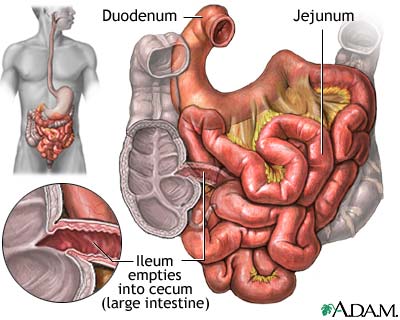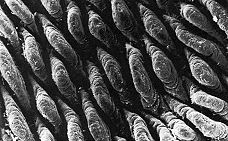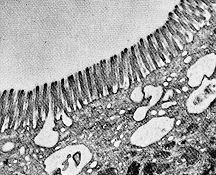Small Intestine
Introduction
Small intestine is the site where most of the nutrient absorptions occurred. After food has been broken down in the stomach by strong hydrochloric acid, the pyloric sphincter opens and food get pushed into small intestine with peristalsis. There are three major structural parts of the small intestine, duodenum, jejunum, and ileum. Throughout these sections, finger-liked structure called villi increase surface area that helps the absorption of nutrients. The small intestine is very sensitive to change in temperature…?
Duodenum, a hollowed tube that situated between the stomach and the jejunum. It is mostly responsible for digesting chyme, food bolus that was created by the churning motion of the stomach. Since it doesn’t have the thick mucus lining like the stomach, the duodenum cannot tolerate the low pH introduced by the chyme. In order to neutralize the pH, liver secrets bile and bicarbonate into the duodenum and brings the pH of duodenum up to around 5 and 6 range, a much more tolerable pH for protein and enzymes to function. Enzymes such as lipase, trypsin and chymotrypsin are also secreted into the duodenum to help digestion.
The jejunum is situated right after the duodenum and it is about 10 feet long. (muhealth) Goblet cells are most numerous in jejunum, although they exist throughout small intestine. (umdnj). The primary function of these cells are to secret mucus lining
Description of Niche
Where located?
Not in the vagina niche
Subniches
Duodenum
The duodenum is the shortest section of the small intestine; it is 26cm long, on average.
Jejunum
The jejunum is 2.5m long, and is the site for absorption. The pH is 7-8 (slightly alkaline).
Ileum
Physical Conditions?
Temperature
Pressure
pH
OVER 9000!
Moisture
Influence by Adjacent Communities
Is your niche close to another niche or influenced by another community of organisms?
Stomach
The stomach is located directly above the small intestine, and it is separated from the duodenum by the pyloric sphincter. As mentioned above, the duodenum has a neutral pH, which is needed because inside the stomach, gastric juice is secreted in order to provide the acidic environment needed to convert the inactive pepsinogen to the active pepsin. As the chyme (the semi-digested foodstuff) enters the duodenum, bile is secreted by the liver through the bile duct, to neutralize the acidic pH from the stomach.
Colon (Large Intestine)
The colon is connected directly to the other end of the small intestine.
Conditions under which the environment changes
Do any of the physical conditions change? Are there chemicals, other organisms, nutrients, etc. that might change the community of your niche.
Who lives there?
Currently no one :( Boo Radley
Which microbes are present?
You may refer to organisms by genus or by genus and species, depending upon how detailed the your information might be. If there is already a microbewiki page describing that organism, make a link to it.
Do the microbes that are present interact with each other?
Describe any negative (competition) or positive (symbiosis) behavior
Do the microbes change their environment?
Do they alter pH, attach to surfaces, secrete anything, etc. etc.
Do the microbes carry out any metabolism that affects their environment?
The microbes of the small intestine carry out a number of functions such as protective, structural, and metabolic functions. 2
Protective Functions
• The natural flora of the small intestine protect the host by taking up space inside the small intestine. The presence of natural flora inside the small intestine prevents pathogens from obtaining a foothold.
• The natural flora of the small intestine provides competition for nutrients making it more difficult for new pathogens to grow.
• The natural flora of the small intestine produces anti-bacterial products to eliminate competition from other pathogens.
Structural Functions
• The structural function of natural flora in the small intestine makes up part of the intestinal barrier
• The natural flora of the small intestine helps in the natural development of the immune system.
Metabolic Functions
• The natural flora of the small intestine protect the host by metabolizing carcinogens in dietary foods.
• The natural flora of the small intestine provide the host with synthesized vitamins, such as biotin and folate.
Microbial Diseases of the Small Intestine
Peptic Ulcers from Helicobacter Pylori
Crohn's Disease (http://www.asm.org/microbe/index.asp?bid=59965)
Salmonellosis (http://www.ncbi.nlm.nih.gov/pubmed/18589722?ordinalpos=15&itool=EntrezSystem2.PEntrez.Pubmed.Pubmed_ResultsPanel.Pubmed_RVDocSum)
Irritable Bowel Syndrome (http://www.ncbi.nlm.nih.gov/pubmed/18700692?ordinalpos=1&itool=EntrezSystem2.PEntrez.Pubmed.Pubmed_ResultsPanel.Pubmed_RVDocSum)
Necrotizing Entercolitis (NEC) (http://www.ncbi.nlm.nih.gov/pubmed/18446181?ordinalpos=18&itool=EntrezSystem2.PEntrez.Pubmed.Pubmed_ResultsPanel.Pubmed_RVDocSum)
Current Research
Enter summaries of the most recent research. You may find it more appropriate to include this as a subsection under several of your other sections rather than separately here at the end. You should include at least FOUR topics of research and summarize each in terms of the question being asked, the results so far, and the topics for future study. (more will be expected from larger groups than from smaller groups)
References
1 Bentley-Hibbert, Dr. Stuart. Small Intestine [The small intestine is the portion of the digestive system most responsible for absorption of nutrients from food into the bloodstream. The pyloric sphincter governs the passage of partly digested food from the stomach into the duodenum. This short first]. Digital image. MedlinePlus Medical Encyclopedia. 25 Oct. 2006. ADAM. 26 Aug. 2008 <http://www.nlm.nih.gov/medlineplus/ency/imagepages/19221.htm>.
JANET'S REFERENCES:
http://www.textbookofbacteriology.net/normalflora.html
Samuel Baron MD; Charles Patrick. Davis (1996). "Bacteriology": Chapter 6. Normal Flora. University of Texas Medical Branch at Galveston.
Sears CL (2005 Oct;11). "A dynamic partnership: celebrating our gut flora". Anaerobe (5):247-51: 247–251. Academic Press.
Edited by [Ellis Chiu, Janet Kwok, Kevin Lee, Susan Lee, Martin Tang, Adnan Vahora], students of Rachel Larsen



